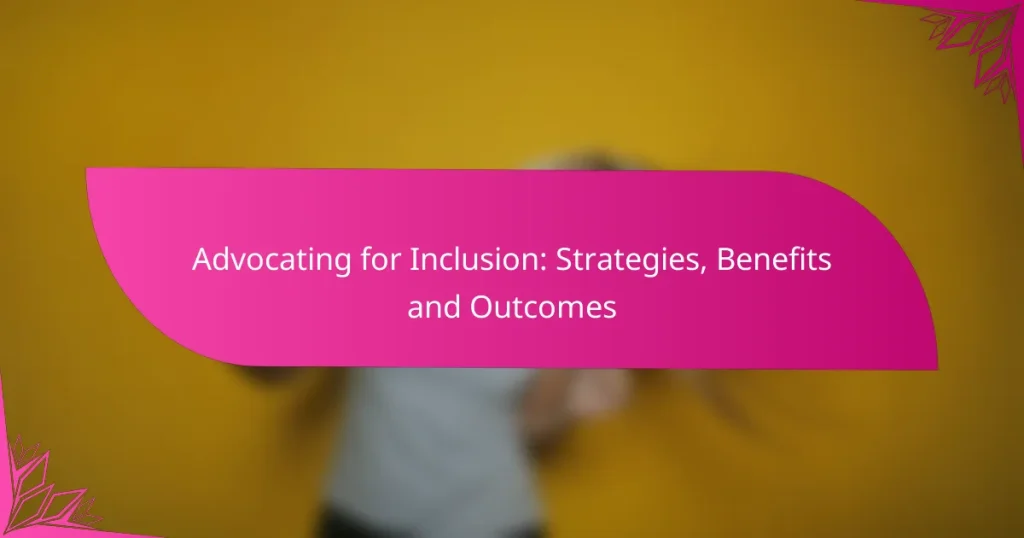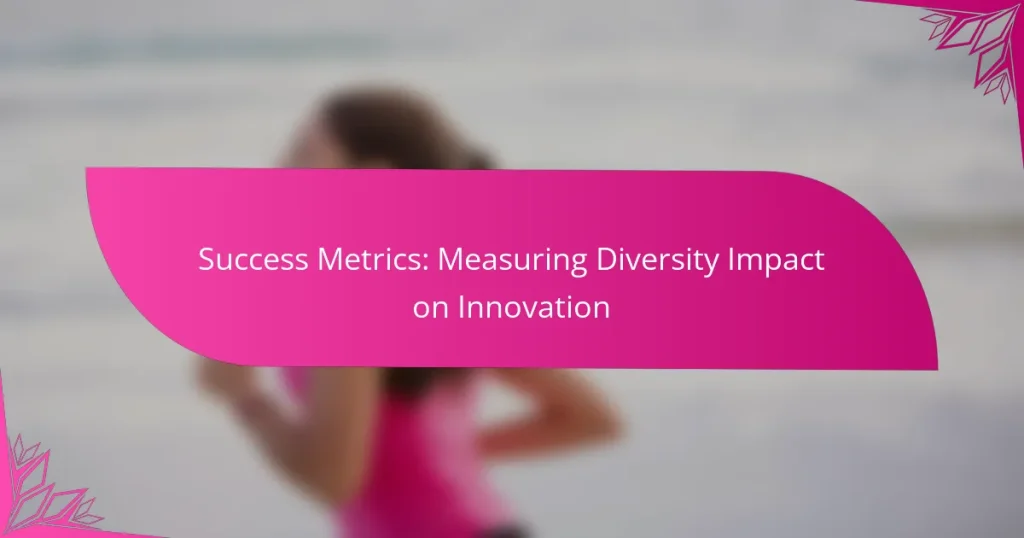Women innovators play a crucial role in enhancing diversity within the technology sector by bringing unique perspectives that address the needs of a wider audience. Their contributions not only promote inclusive environments but also drive innovation, resulting in products and services that resonate with diverse populations. Implementing effective diversity and inclusion initiatives is essential for organizations to empower underrepresented individuals and foster equitable representation across various fields.
Diversity Initiatives: Successful Case Studies in Tech Companies
Diversity Programs: Effectiveness, Impact and Best Practices
Advocating for Inclusion: Strategies, Benefits and Outcomes
Navigating Challenges: Diverse Work Environments and Support
Success Metrics: Measuring Diversity Impact on Innovation
Company Cultures: Women-Friendly Tech Firms and Practices
How are women innovators driving diversity in technology?
Women innovators are significantly enhancing diversity in technology by introducing unique perspectives and solutions that cater to a broader audience. Their involvement not only fosters inclusive environments but also drives innovation, leading to products and services that better meet the needs of diverse populations.
Increased representation in leadership roles
Women are increasingly occupying leadership positions in tech companies, which is crucial for promoting diversity. This representation helps to shape company culture and decision-making processes, ensuring that women’s voices and experiences are considered in strategic initiatives.
Organizations that prioritize gender diversity in leadership often see improved performance and employee satisfaction. Companies can implement mentorship programs and diversity training to support women in climbing the corporate ladder.
Innovative tech solutions addressing women’s needs
Women innovators are developing technology solutions specifically designed to address challenges faced by women. This includes apps for health monitoring, safety, and financial literacy, which cater to unique needs and preferences.
For example, platforms that focus on women’s health issues or financial management tools tailored for female entrepreneurs are gaining traction. These innovations not only empower women but also create market opportunities that benefit society as a whole.
Case studies of successful women-led startups
Numerous women-led startups have emerged as leaders in their fields, showcasing the impact of female entrepreneurship on innovation. Companies like Bumble, founded by Whitney Wolfe Herd, have transformed industries by prioritizing user safety and inclusivity in their platforms.
Another example is Glossier, led by Emily Weiss, which revolutionized the beauty industry by focusing on community-driven product development. These case studies illustrate how women-led initiatives can lead to significant advancements in technology and business practices.
What are effective diversity and inclusion initiatives?
Effective diversity and inclusion initiatives are structured programs and policies designed to promote equitable representation and participation of diverse groups within organizations. These initiatives often focus on creating supportive environments that empower underrepresented individuals, particularly women, in various fields.
Mentorship programs for women in STEM
Mentorship programs for women in STEM (Science, Technology, Engineering, and Mathematics) connect experienced professionals with emerging female talent. These programs provide guidance, support, and networking opportunities, helping women navigate challenges in male-dominated fields.
Successful mentorship initiatives often include structured pairings, regular check-ins, and skill-building workshops. For example, companies might implement a six-month mentorship program where mentors and mentees meet bi-weekly to discuss career goals and strategies.
Corporate partnerships promoting gender equity
Corporate partnerships that promote gender equity involve collaborations between businesses and organizations aimed at advancing women’s rights and opportunities in the workplace. These partnerships can lead to shared resources, joint initiatives, and increased visibility for gender equity issues.
For instance, a tech company might partner with a nonprofit focused on women’s education to create internship programs specifically for young women. Such collaborations can enhance corporate social responsibility efforts while fostering a diverse talent pipeline.
How can organizations implement diversity initiatives?
Organizations can implement diversity initiatives by establishing clear goals, creating inclusive policies, and fostering an environment that values diverse perspectives. This involves assessing current practices, engaging employees, and committing to ongoing training and evaluation.
Creating inclusive workplace policies
Inclusive workplace policies are essential for promoting diversity. Organizations should develop guidelines that address recruitment, retention, and promotion practices to ensure equal opportunities for all employees. For example, implementing flexible work arrangements can accommodate different needs, such as caregiving responsibilities.
Additionally, organizations should regularly review their policies to identify any barriers that may hinder diversity. Engaging employees in this process can provide valuable insights and foster a sense of ownership in the initiatives.
Training programs on unconscious bias
Training programs on unconscious bias help employees recognize and mitigate their biases, leading to a more inclusive workplace. These programs can include workshops, online courses, or interactive sessions that encourage self-reflection and discussion. A well-structured program typically lasts a few hours to a full day, depending on the depth of content.
Organizations should ensure that training is ongoing and not a one-time event. Regular refreshers and follow-up sessions can reinforce learning and promote a culture of continuous improvement. It’s also beneficial to measure the effectiveness of these programs through employee feedback and diversity metrics.
What metrics measure the success of diversity initiatives?
Success in diversity initiatives can be measured through various metrics that reflect employee experiences and hiring practices. Key indicators include employee satisfaction surveys and diversity hiring statistics, which provide insights into the effectiveness of these initiatives.
Employee satisfaction surveys
Employee satisfaction surveys are essential tools for gauging the impact of diversity initiatives within an organization. These surveys typically include questions about inclusivity, workplace culture, and employees’ feelings of belonging. High satisfaction scores often correlate with successful diversity efforts.
To effectively use these surveys, organizations should ensure anonymity to encourage honest feedback. Regularly conducting these surveys, perhaps annually or biannually, can help track progress and identify areas needing improvement.
Diversity hiring statistics
Diversity hiring statistics provide quantitative data on the effectiveness of recruitment strategies aimed at increasing workforce diversity. Organizations should track the percentage of hires from underrepresented groups, as well as retention rates for these employees over time.
For practical assessment, companies can set specific diversity hiring goals, such as aiming for a certain percentage of new hires to come from diverse backgrounds. Monitoring these statistics regularly can help organizations adjust their hiring practices and ensure they are fostering an inclusive environment.
What challenges do women innovators face?
Women innovators encounter various challenges that can hinder their ability to succeed in their ventures. These obstacles include limited access to funding, gender bias in hiring practices, and a lack of representation in leadership roles.
Lack of funding for women-led ventures
Women-led ventures often struggle to secure funding compared to their male counterparts. Research indicates that only a small percentage of venture capital goes to female entrepreneurs, which can limit their growth potential and market reach.
To improve funding opportunities, women innovators should consider alternative sources such as crowdfunding, angel investors, and grants specifically aimed at supporting female-led businesses. Networking with other women in the industry can also lead to valuable connections and potential funding sources.
Gender bias in hiring and promotions
Gender bias in hiring and promotions remains a significant barrier for women innovators. This bias can manifest in various ways, such as assumptions about women’s commitment to their careers or their capabilities in leadership roles.
To combat gender bias, companies should implement transparent hiring practices and promote diversity in their recruitment processes. Additionally, organizations can provide training on unconscious bias for hiring managers and establish mentorship programs to support women’s career advancement.
How can mentorship improve women’s representation?
Mentorship can significantly enhance women’s representation by providing guidance, support, and opportunities for professional growth. Through mentorship, women gain access to valuable insights and networks that can help them navigate their careers more effectively.
Access to networks and resources
Mentorship opens doors to extensive professional networks and resources that might otherwise be inaccessible. Mentors can introduce mentees to key industry contacts, which can lead to job opportunities, collaborations, and partnerships.
Additionally, mentors often share resources such as industry reports, training programs, and workshops that can further aid in career advancement. This access can be particularly beneficial in fields where women are underrepresented.
Building confidence and skills
Mentorship helps women build confidence by providing a safe space to discuss challenges and seek advice. A supportive mentor can encourage mentees to take risks, voice their opinions, and pursue leadership roles, which can be crucial for career progression.
Moreover, mentors can assist in skill development by offering constructive feedback and identifying areas for improvement. This guidance can help women enhance their competencies, making them more competitive in the job market.
What role do educational institutions play in fostering innovation?
Educational institutions are crucial in fostering innovation by providing resources, mentorship, and a collaborative environment that encourages creativity. They offer programs and initiatives that specifically target underrepresented groups, helping to build a diverse pipeline of future innovators.
Programs encouraging girls in STEM
Programs aimed at encouraging girls in STEM (Science, Technology, Engineering, and Mathematics) focus on building confidence and skills through hands-on learning experiences. Initiatives such as coding camps, robotics clubs, and science fairs are designed to engage young girls and spark their interest in these fields.
Many schools partner with organizations to create mentorship opportunities, where female role models in STEM fields guide and inspire students. This exposure can significantly influence girls’ career choices and aspirations, helping to close the gender gap in technology and engineering sectors.
Partnerships with tech companies for internships
Partnerships between educational institutions and tech companies provide students with valuable internship opportunities that enhance their practical skills and employability. These collaborations often lead to real-world projects where students can apply their classroom knowledge in a professional setting.
Internships can vary in duration, typically ranging from a few weeks to several months, and may offer stipends or hourly wages. Such experiences not only enrich students’ resumes but also help them build networks within the industry, increasing their chances of securing full-time positions after graduation.
What are emerging trends in women-led innovation?
Emerging trends in women-led innovation focus on collaboration, technology, and addressing social challenges. Women innovators are increasingly leveraging their unique perspectives to drive change in various sectors, emphasizing inclusivity and sustainability.
Focus on sustainability and social impact
Women-led initiatives often prioritize sustainability and social impact, aiming to create solutions that benefit communities and the environment. This approach not only addresses pressing global issues but also resonates with consumers who value ethical practices.
For instance, women entrepreneurs in the fashion industry are developing eco-friendly materials and promoting fair labor practices. Similarly, tech startups led by women are creating platforms that enhance access to education and healthcare in underserved areas.
To effectively focus on sustainability, innovators should consider integrating environmental assessments into their business models. This can involve setting measurable goals, such as reducing carbon footprints or sourcing materials locally, which can enhance brand loyalty and attract socially conscious investors.






